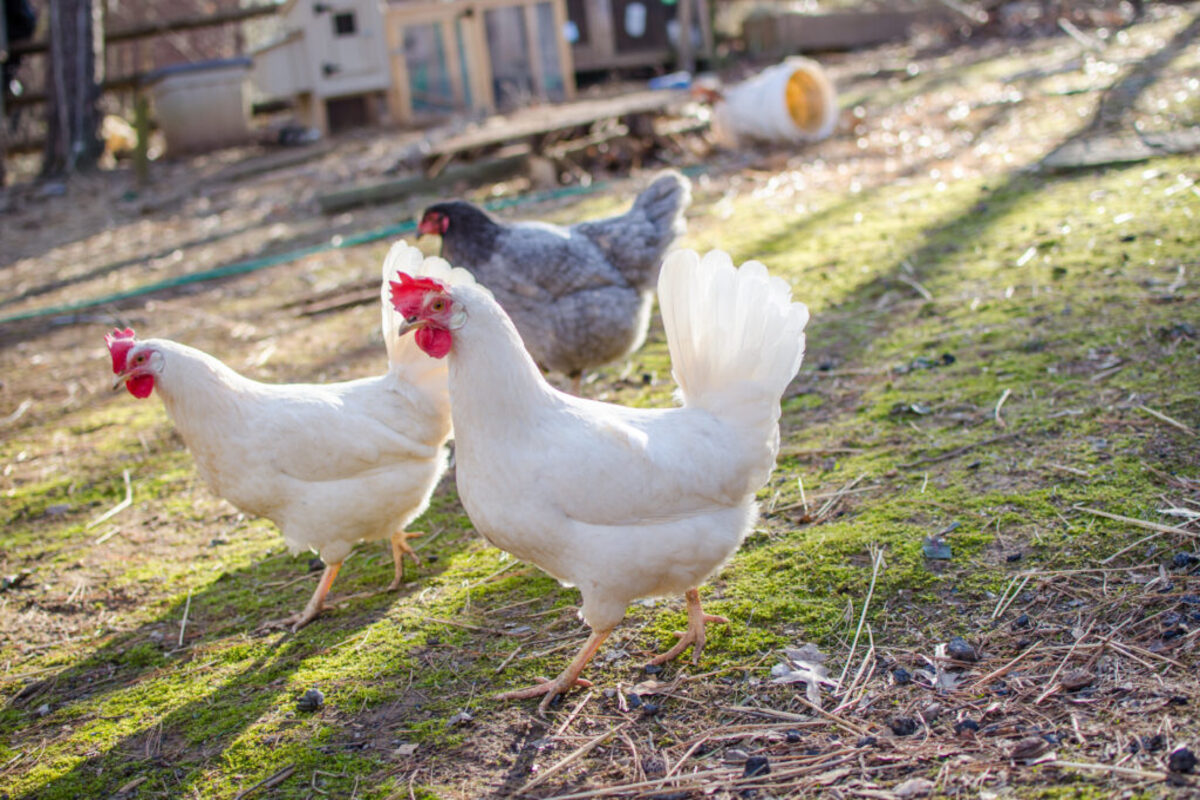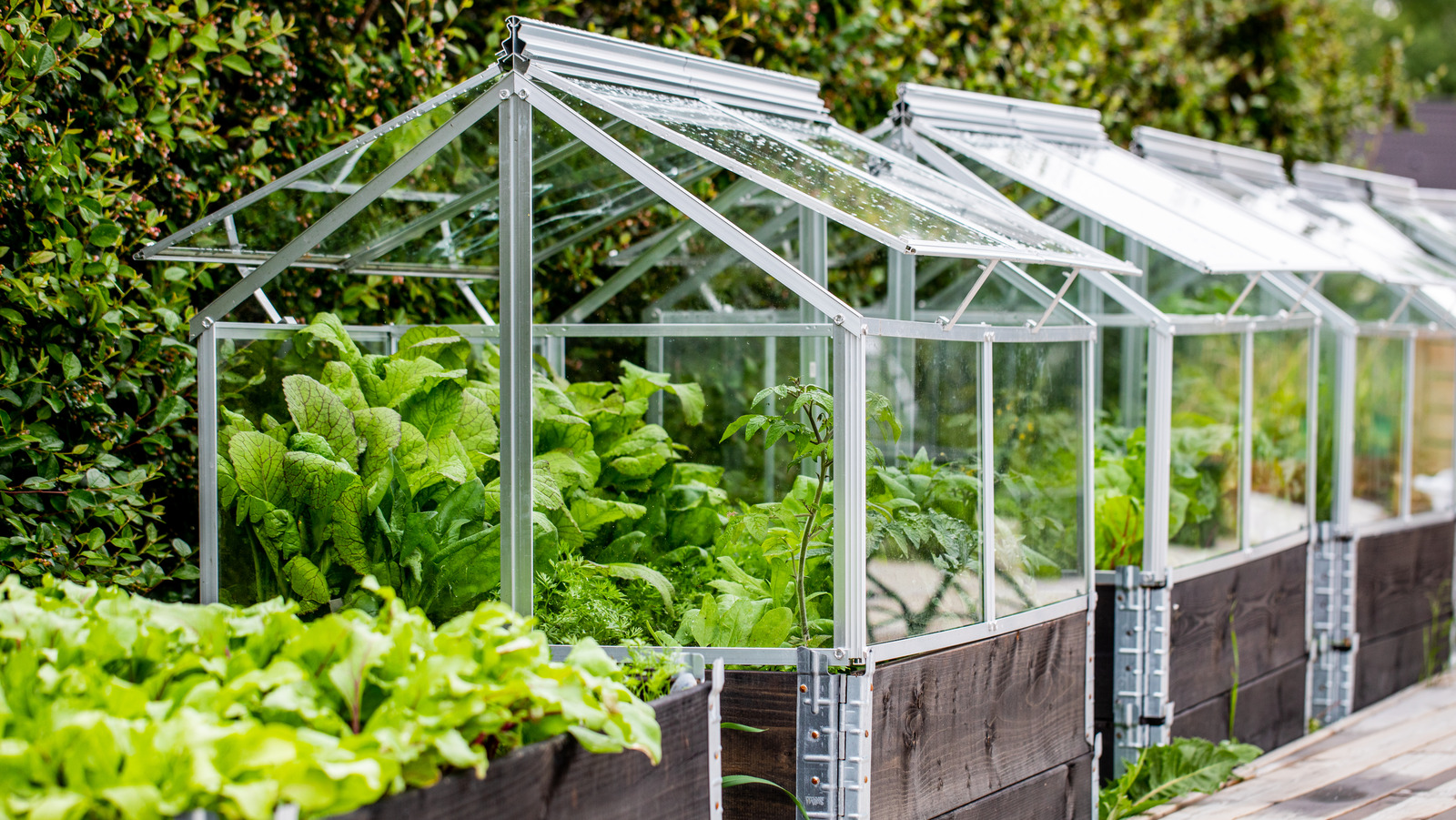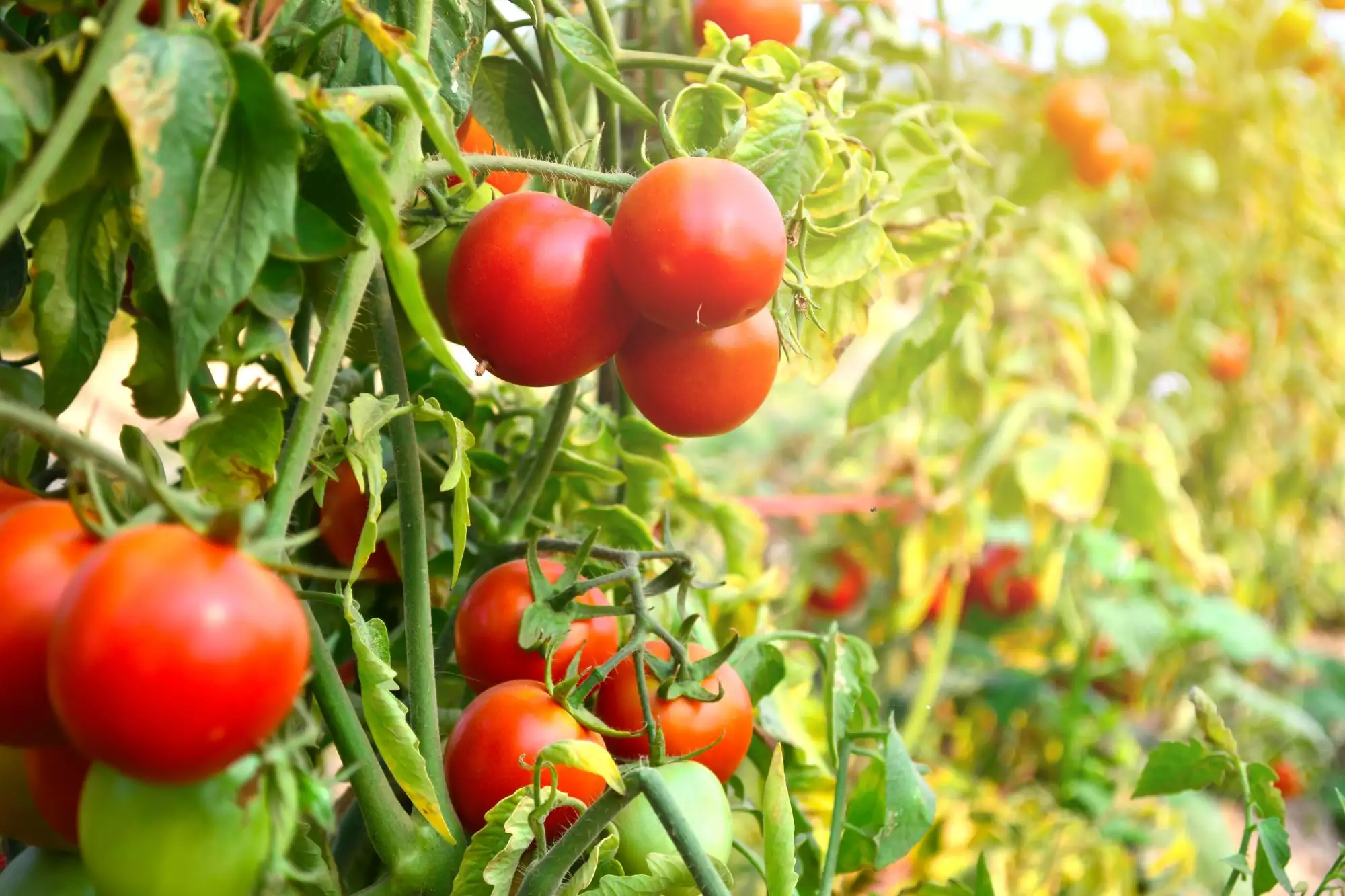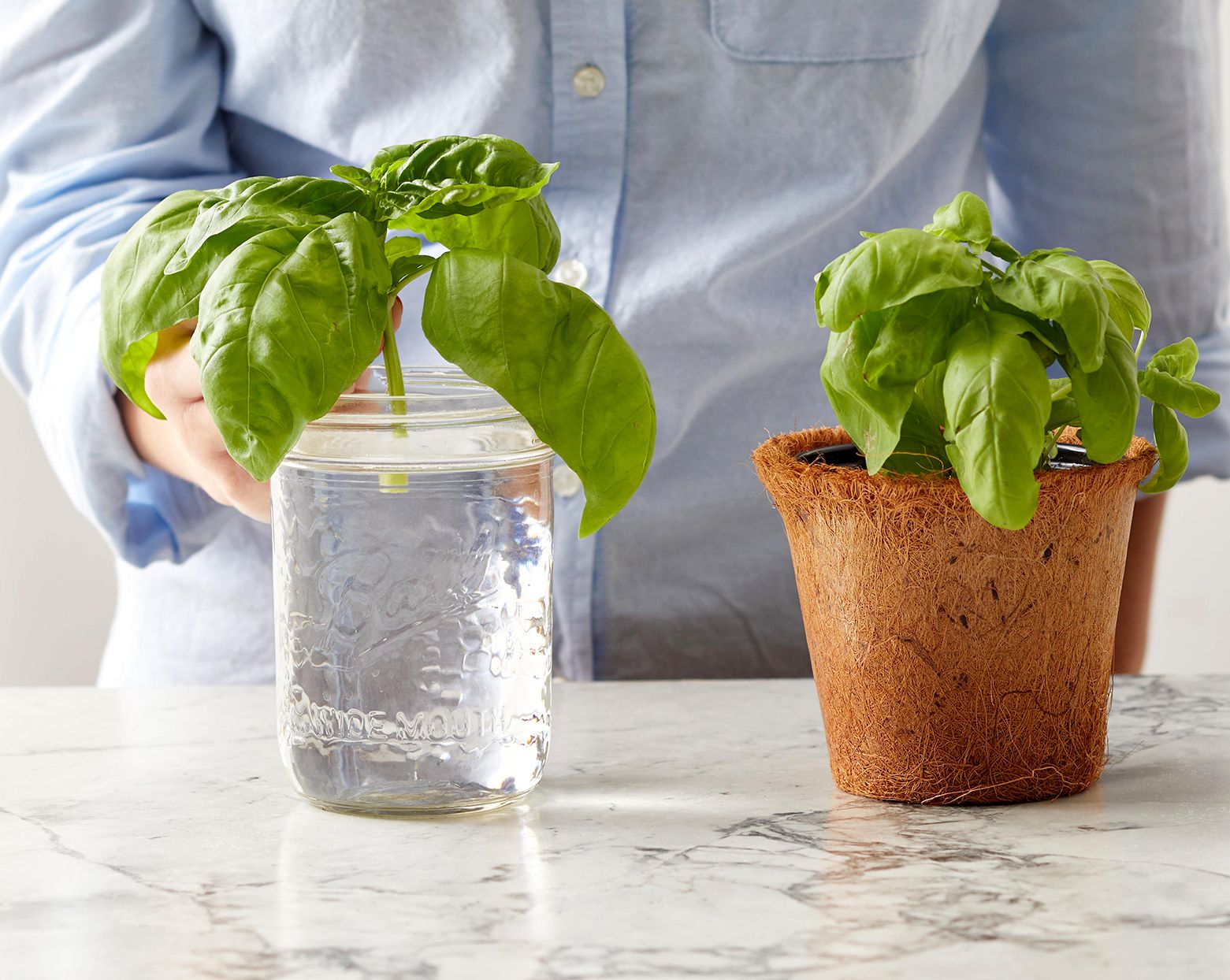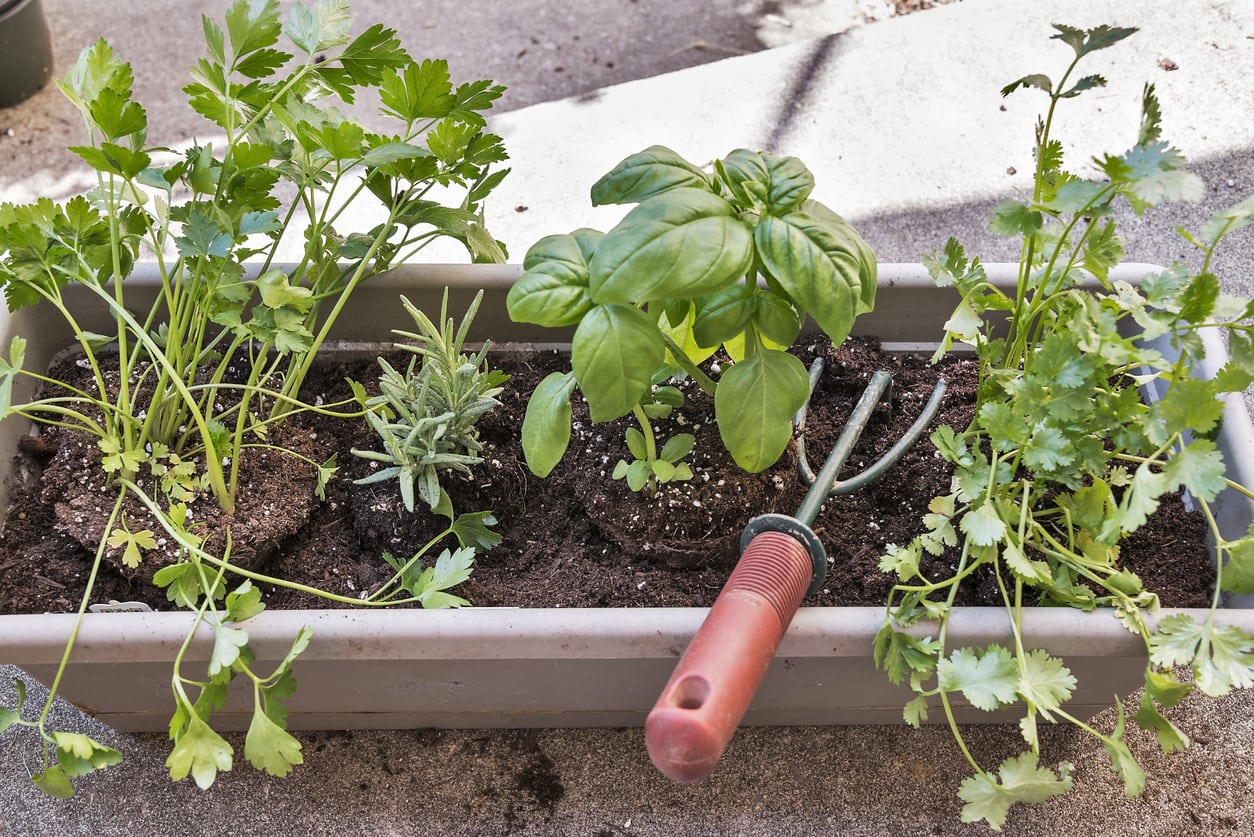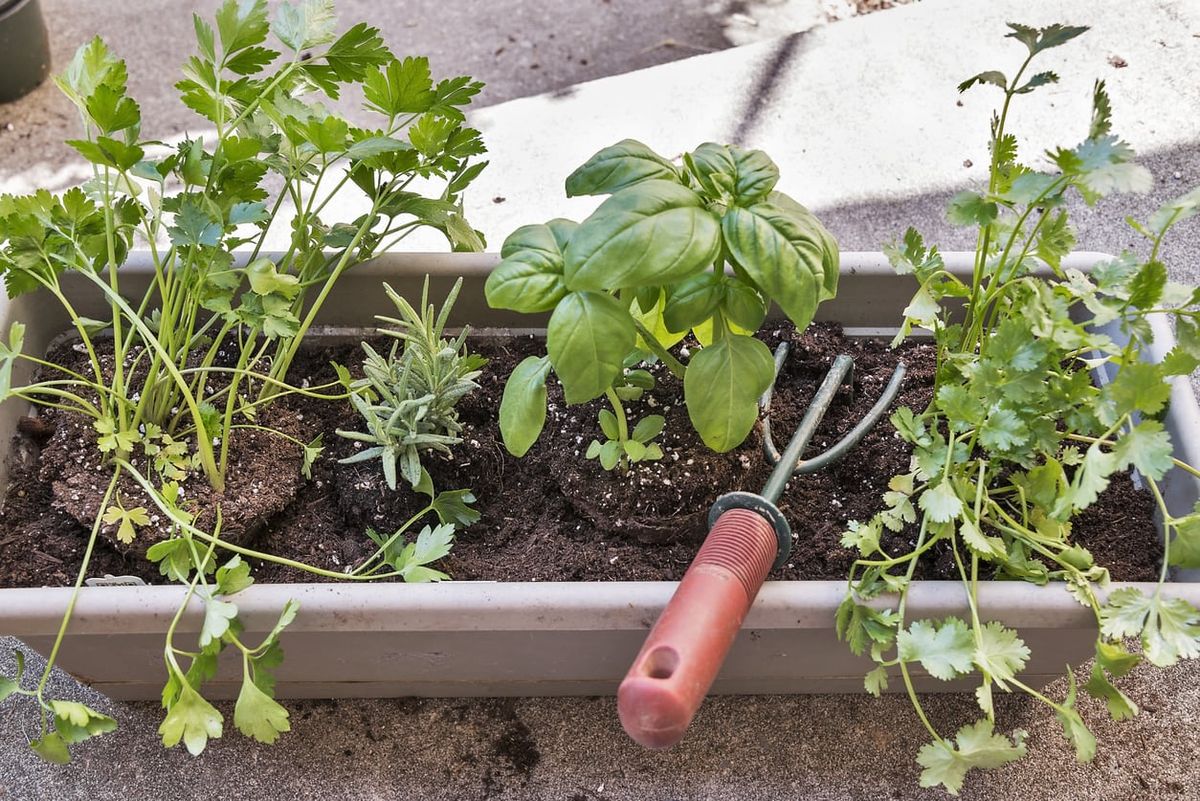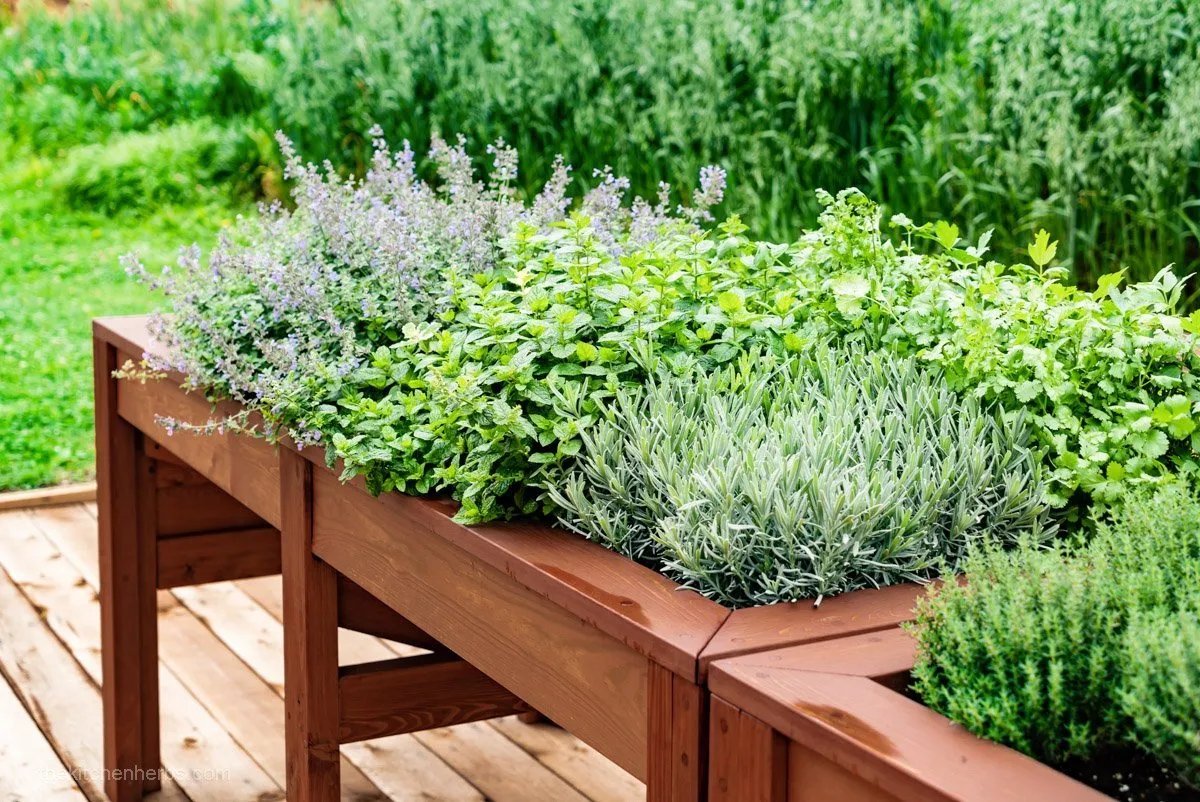Home>Gardening News and Trends>Gardening Trends>What Herbs Can Be Planted With Tomatoes


Gardening Trends
What Herbs Can Be Planted With Tomatoes
Modified: January 22, 2024
Discover the latest gardening trends and learn which herbs can be successfully planted with tomatoes for a thriving and flavorful garden.
(Many of the links in this article redirect to a specific reviewed product. Your purchase of these products through affiliate links helps to generate commission for Chicagolandgardening.com, at no extra cost. Learn more)
Table of Contents
Introduction
Welcome to the world of companion planting in gardening! If you’re a gardening enthusiast, you may have heard of the concept of planting certain herbs together with specific crops. This practice, known as companion planting, is not only an age-old tradition but also a strategic way to improve the health, yield, and flavor of your plants.
When it comes to tomatoes, companion planting can be highly beneficial. Tomatoes are one of the most popular crops for gardeners due to their versatility in the kitchen and vibrant colors in the garden. However, they can also be prone to pests and diseases. This is where the power of companion plants comes into play.
Companion planting involves strategically pairing plants that have mutual benefits for each other. By selecting the right herbs to grow alongside your tomato plants, you can create a harmonious ecosystem that fosters growth, deters pests, improves soil health, and enhances overall plant health.
In this article, we will explore the world of companion planting for tomatoes and discover some of the best herbs to plant alongside them. These herbs not only provide natural pest control but also improve the flavor of tomatoes and help to boost their growth.
Benefits of Companion Planting
Companion planting offers a myriad of benefits for your tomato plants. Let’s delve into some of the key advantages:
- Pest Control: Certain herbs have natural properties that act as repellents for pests that commonly affect tomatoes. By interplanting these herbs, you can create a natural barrier, reducing the risk of pests damaging your tomato plants.
- Disease Prevention: Tomatoes are susceptible to various diseases, such as blight and powdery mildew. However, some companion plants release volatile compounds that help inhibit the growth of these diseases, offering protection to your precious tomatoes.
- Improved Flavor: Companion plants like basil and parsley not only ward off pests but can also enhance the flavor of tomatoes when grown nearby. The aromatic compounds released by these herbs can infuse your tomatoes with a delightful and savory taste.
- Enhanced Growth: Some herbs, such as borage and marigold, have deep taproots that help loosen and aerate the soil. This improves drainage and nutrient uptake, leading to healthier tomato plants with enhanced growth and productivity.
- Weed Suppression: Companion plants can act as natural mulch, shading the soil and suppressing weed growth. This reduces competition for vital nutrients and water, allowing your tomato plants to thrive without the interference of pesky weeds.
- Attracting Beneficial Insects: The presence of certain herbs, like dill and chives, can attract beneficial insects such as pollinators and predatory insects. These insects help in the pollination of tomato flowers and serve as natural pest controllers, keeping harmful insects at bay.
By understanding and harnessing the benefits of companion planting, you can create a harmonious and thriving garden where your tomatoes can truly flourish.
Choosing the Right Herbs for Tomato Companion Planting
When it comes to selecting the right herbs for tomato companion planting, it’s essential to consider their compatibility, pest-repellent properties, and overall benefits to the tomato plants. Here are ten herbs that make excellent companions for tomatoes:
- Basil: Basil is not only a delicious herb in the kitchen but also acts as a natural repellent for tomato pests like aphids, flies, and mosquitoes. Its aromatic leaves can enhance the flavor of tomatoes when grown nearby.
- Marigold: Marigold flowers emit a scent that repels a wide range of garden pests, including nematodes and whiteflies. Planting marigolds around your tomato plants can help protect them from these destructive pests.
- Borage: Borage is a fantastic companion for tomatoes as it attracts pollinators and beneficial insects like bees, wasps, and ladybugs. Its deep taproots also help improve soil structure and nutrient absorption.
- Nasturtium: Nasturtiums not only add beautiful splashes of color to your garden but also deter aphids, whiteflies, and other pests that cause damage to tomato plants. The flowers and leaves are also edible and make a delightful addition to salads.
- Parsley: This herb is not just a culinary staple; it also helps repel insects harmful to tomatoes, such as asparagus beetles and spider mites. Parsley’s deep roots also improve soil structure and nutrient availability.
- Chives: Chives release a pungent scent that deters pests like aphids and Japanese beetles. Planting chives near your tomato plants can help protect them from these common garden nuisances.
- Dill: Dill attracts beneficial insects like hoverflies and wasps, which feed on destructive pests like aphids. Its delicate foliage and towering flowers add beauty and interest to your garden.
- Oregano: Oregano not only adds flavor to your culinary creations but also acts as a natural repellent for pests like aphids and spider mites. Its aromatic leaves also provide additional pest control.
- Thyme: Thyme is a versatile herb that repels tomato pests like whiteflies, cabbage loopers, and hornworms. This aromatic herb also attracts beneficial pollinators to your garden.
- Mint: Mint is a vigorous herb that can help deter pests such as ants, flea beetles, and rodents. However, it is important to plant mint in containers or use barriers as it can spread rapidly and become invasive.
By incorporating these companion herbs into your tomato garden, you can create a thriving ecosystem that promotes healthy growth, deters pests, and enhances the flavor of your tomatoes.
Basil
Basil is a versatile and aromatic herb that serves as an excellent companion for tomatoes in the garden. Not only does it add a delightful fragrance to the air, but it also offers numerous benefits to tomato plants.
One of the primary advantages of planting basil alongside tomatoes is its natural pest-repellent properties. Basil has a strong scent that acts as a deterrent for pests like aphids, flies, and mosquitoes. By interplanting basil with tomato plants, you can help protect your tomatoes from these nuisances.
Furthermore, the presence of basil can enhance the overall flavor of tomatoes. The aromatic compounds released by basil leaves can infuse the tomatoes with a unique and savory taste. This combination of flavors makes basil and tomatoes a classic culinary pairing.
When it comes to companionship, basil is a reliable partner for tomatoes as they have similar care requirements. Both plants prefer full sun and well-drained soil. By planting them together, you can ensure they receive the ideal growing conditions they need to thrive.
There are several varieties of basil available, each with its unique flavor profile. Sweet basil, with its large, fragrant leaves, is the most commonly used type in cooking. Other varieties, such as Genovese basil and purple basil, offer a slightly different taste and appearance, adding visual interest to your garden.
To maximize the benefits of companion planting with basil, it’s recommended to plant it at the base of your tomato plants or in close proximity. This way, the fragrance can envelop the tomatoes, deterring pests and enhancing their flavor.
In addition to its role as a companion plant, basil also has numerous uses in the kitchen. Its leaves are a key ingredient in pestos, sauces, and fresh salads. Harvesting the leaves regularly not only promotes bushier growth but also provides you with a fresh supply of this flavorful herb.
Overall, the addition of basil to your tomato garden not only offers natural pest control but also elevates the taste of your tomatoes, making it a must-have companion plant for every tomato enthusiast.
Marigold
Marigolds have long been recognized as a valuable companion plant for tomatoes due to their pest-repellent properties and vibrant blooms. Planting marigolds alongside your tomato plants can provide numerous benefits and contribute to a healthy and thriving garden.
One of the key advantages of growing marigolds with tomatoes is their ability to repel a wide range of garden pests. Marigold flowers release a distinct scent that acts as a natural deterrent for pests like nematodes, whiteflies, aphids, and other insects that can cause damage to tomato plants. This pest-repellent effect can help protect your tomatoes and prevent infestations without the need for chemical pesticides.
Marigolds also offer an additional layer of protection by attracting beneficial insects such as ladybugs and hoverflies. These beneficial insects are natural predators of common tomato pests and can help keep their populations in check. The presence of marigolds in your garden can act as a beacon for these helpful insects, promoting a balanced and eco-friendly ecosystem.
In addition to their pest-repellent properties, marigolds also contribute to the health of tomato plants by improving soil quality. Their extensive root system helps to break up compacted soil, improving drainage and aeration. Marigolds also produce organic matter as they decompose, enriching the soil with nutrients over time.
When selecting marigolds for companion planting, consider the French marigold (Tagetes patula) and African marigold (Tagetes erecta) varieties. French marigolds have a compact growth habit and come in a variety of colors, while African marigolds have larger flowers and are available in vibrant shades of yellow and orange. Both varieties are suitable for companion planting with tomatoes.
When planting marigolds, ensure they are spaced evenly throughout your tomato bed. Their strong scent works best when it is evenly distributed, creating a repellent barrier. Interplant them directly in the ground or use them as border plants around your tomato plants.
It is important to note that marigolds are typically annual plants, meaning they will need to be replanted each year. However, their numerous benefits as a companion plant for tomatoes make them a worthwhile addition to your garden.
Overall, growing marigolds alongside your tomato plants not only adds a vibrant touch to your garden but also provides natural pest control and soil improvement, creating a beneficial environment for your tomatoes to thrive.
Borage
Borage (Borago officinalis) is an herb with beautiful blue flowers that serves as an excellent companion plant for tomatoes. This versatile herb offers numerous benefits to your tomato plants and can enhance the overall health and productivity of your garden.
One of the key advantages of growing borage alongside tomatoes is its ability to attract beneficial insects. The bright blue flowers of borage act as magnets for pollinators, such as bees and butterflies, that are essential for the successful fertilization of tomato flowers. By attracting these pollinators, borage helps ensure a higher fruit set and improves the overall yield of your tomato plants.
In addition to attracting pollinators, borage also attracts beneficial insects such as predatory wasps and hoverflies. These insects feed on pests like aphids and caterpillars, keeping their populations in check and protecting your tomato plants from damage.
Borage also has an extensive root system with deep taproots that help break up compacted soil and enhance drainage. This improves the overall soil structure and allows for better penetration of water and nutrients, benefiting not only the tomatoes but all the plants in the vicinity.
The leaves of borage are rich in calcium and potassium, which are essential nutrients for healthy plant growth. As the leaves decompose, they release these nutrients into the soil, enriching it and promoting the overall health of your tomato plants.
When it comes to planting borage with tomatoes, it is best to sow the seeds directly in the garden bed or in containers around your tomato plants. Borage is an easy-to-grow herb that prefers full sun and well-drained soil. The plants can grow quite tall, reaching around 2 to 3 feet in height, so make sure to give them adequate space to spread out.
Borage has a mild cucumber-like flavor and is often used in salads and beverages. The leaves and flowers of borage are edible and can add a unique touch to your culinary creations.
Overall, borage is a fantastic companion plant for tomatoes. Its ability to attract beneficial insects, improve soil health, and enhance pollination makes it a valuable addition to any tomato garden.
Nasturtium
Nasturtiums (Tropaeolum) are vibrant and versatile flowers that make excellent companions for tomatoes in the garden. With their beautiful blooms and edible leaves, nasturtiums offer both visual appeal and several benefits for your tomato plants.
One of the key advantages of growing nasturtiums alongside tomatoes is their ability to deter pests. Nasturtiums emit a strong scent that repels various insects, including aphids, whiteflies, and squash bugs. By interplanting nasturtiums with your tomato plants, you can create a natural barrier that helps protect your tomatoes from infestations and minimize damage caused by these pests.
In addition to pest control, nasturtiums attract beneficial insects that can help protect your tomatoes. The bright, showy flowers of nasturtiums serve as a beacon for pollinators like bees and butterflies, aiding in the pollination process and increasing the fruit set of your tomatoes. Furthermore, nasturtiums attract predatory insects, such as ladybugs and hoverflies, which feed on harmful pests, including aphids and caterpillars.
Nasturtiums are also edible, making them a unique addition to your culinary creations. Both the flowers and leaves of nasturtiums have a peppery flavor that adds a zesty kick to salads, sandwiches, and other dishes. Their vibrant colors can also be used to garnish meals, adding a visually appealing touch to your culinary masterpieces.
When it comes to planting nasturtiums with tomatoes, it’s best to sow the seeds directly in the garden bed or in containers. Nasturtiums prefer well-drained soil and can tolerate partial shade, although they thrive in full sun. Space the plants a few inches apart to allow for proper growth and air circulation.
As nasturtiums grow, their trailing vines can help shade the soil around your tomato plants, reducing weed growth and conserving moisture. This acts as a natural mulch, preventing the soil from drying out too quickly and reducing the need for frequent watering.
With their pest-repellent properties, ability to attract beneficial insects, and edible blooms, nasturtiums are a valuable addition to any tomato garden. Not only will they assist in protecting and enhancing the growth of your tomatoes, but they will also add a pop of color and flavor to your culinary creations.
Parsley
Parsley (Petroselinum crispum) is a versatile herb that serves as an excellent companion plant for tomatoes. Not only does parsley add a fresh and vibrant touch to your garden, but it also provides several benefits to your tomato plants.
One of the key advantages of planting parsley alongside tomatoes is its ability to repel pests. Parsley emits a strong scent that acts as a natural deterrent for insects harmful to tomatoes, including asparagus beetles and spider mites. By interplanting parsley with your tomatoes, you can help protect them from these destructive pests and minimize the need for chemical interventions.
Parsley also improves the overall flavor of tomatoes when grown nearby. The aromatic compounds released by parsley leaves can enhance the taste of tomatoes, adding a pleasant and savory note to your culinary creations. The combination of parsley and tomatoes is a classic pairing in many dishes and sauces.
Furthermore, parsley has deep taproots that help improve soil structure and nutrient availability. Its roots break up compacted soil, promoting better drainage and aeration. This leads to healthier tomato plant roots and improved nutrient uptake, resulting in enhanced growth and productivity.
Parsley is relatively easy to grow and prefers full sun or partial shade. Start parsley seeds indoors or directly sow them in the garden after the danger of frost has passed. Keep the soil evenly moist, and thin the seedlings to allow proper spacing and airflow between plants.
Harvesting parsley leaves regularly not only provides you with fresh herbs for cooking but also promotes bushier growth. Remove older, yellowing leaves to encourage new growth and maintain the overall health and appearance of your parsley plants.
Aside from its benefits as a companion plant for tomatoes, parsley is a staple in many culinary dishes. It is commonly used in soups, salads, sauces, and garnishes. Adding parsley to your meals not only enhances flavor but also provides a nutritional boost, as it is rich in vitamins A, C, and K.
In summary, planting parsley alongside your tomato plants offers pest control, flavor enhancement, and soil improvement. Its versatile nature and culinary uses make it a valuable addition to any tomato garden.
Chives
Chives (Allium schoenoprasum) are a versatile herb that not only adds a delightful flavor to your culinary creations but also serves as an excellent companion plant for tomatoes. Planting chives alongside your tomatoes can offer several benefits, including natural pest control and enhanced growth.
One of the key advantages of growing chives with tomatoes is their ability to repel pests. Chives emit a pungent scent that acts as a natural deterrent for aphids and Japanese beetles, both of which can cause damage to tomato plants. By interplanting chives with your tomatoes, you can help protect them from these common garden nuisances.
In addition to pest control, chives also attract beneficial insects to your garden. The pom-pom-like flowers of chives are highly attractive to pollinators such as bees and butterflies. By attracting these beneficial insects, chives can aid in the pollination of tomato flowers, resulting in improved fruit set and overall yield.
Chives have shallow root systems that do not compete significantly with tomato plants for nutrients and moisture. This makes them an excellent companion as they can be interplanted between tomato plants without interfering with their growth. The dense clumps of chive foliage also provide some shade for the soil, reducing weed growth and conserving moisture.
When it comes to growing chives, they prefer full sun but can tolerate partial shade. They thrive in well-drained soil and should be watered regularly to keep the soil evenly moist. Harvesting the chive leaves regularly not only promotes new growth but also provides you with a fresh supply of this flavorful herb for your culinary endeavors.
Chives have a mild onion flavor and are commonly used in cooking, particularly in dishes like salads, soups, and omelets. Their delicate leaves make a beautiful garnish, adding both visual appeal and a hint of freshness.
Aside from their benefits as a companion plant, chives are rich in vitamins A and C, as well as minerals like calcium and iron. Including chives in your meals not only enhances flavor but also provides a nutritional boost to your diet.
In summary, planting chives alongside your tomato plants offers natural pest control, attracts beneficial insects, and provides culinary versatility. Their pungent scent and shallow root system make them an ideal companion for tomatoes, ensuring a harmonious and thriving garden.
Dill
Dill (Anethum graveolens) is a flavorful and aromatic herb that serves as a beneficial companion plant for tomatoes. With its feathery foliage and delicate yellow flowers, dill not only adds beauty to your garden but also provides several advantages to your tomato plants.
One of the key benefits of growing dill alongside tomatoes is its ability to attract beneficial insects. The flowers of dill, which bloom in umbels, act as a magnet for hoverflies and wasps. These insects are natural predators of pests like aphids, caterpillars, and whiteflies, keeping their populations in check and protecting your tomato plants from damage.
In addition to attracting beneficial insects, dill can also aid in the pollination of tomatoes. The flowers of dill attract bees, butterflies, and other pollinators that play a crucial role in the fertilization process of tomato flowers. This can promote higher fruit set and improve the overall yield of your tomato plants.
Dill also has a unique aroma that helps deter certain pests. Its strong scent can repel aphids and other insects that can be harmful to tomatoes. By interplanting dill with your tomatoes, you create a natural barrier that helps protect your plants from pest infestations.
When it comes to growing dill, it is a relatively low-maintenance herb. Dill prefers full sun and well-drained soil. It can be directly seeded in the garden bed or grown in containers. The plants can grow quite tall, reaching up to 3 feet in height, so make sure to provide adequate support or space them out to prevent crowding.
Harvesting the foliage and seeds of dill is a rewarding experience. The feathery leaves are flavorful and commonly used in pickles, salads, dips, and sauces. The seeds of dill can be harvested and used as a spice or seasoning, adding a distinct flavor to dishes.
It’s worth noting that dill is an annual herb, meaning it completes its life cycle in one growing season. However, dill readily self-seeds, allowing it to reappear in your garden year after year if you let some plants go to seed.
In summary, planting dill alongside your tomato plants attracts beneficial insects, aid in pollination, and provides a delightful aroma. Its flavorful leaves and seeds make it a versatile herb in the kitchen, adding both taste and visual interest to your culinary creations.
Oregano
Oregano (Origanum vulgare) is a flavorful and aromatic herb that makes an excellent companion plant for tomatoes. Known for its distinct taste and delightful fragrance, oregano offers several benefits to your tomato plants and garden ecosystem.
One of the key advantages of planting oregano alongside tomatoes is its ability to repel pests. Oregano contains volatile oils with strong aromas that act as natural deterrents for pests like aphids, spider mites, and whiteflies. By interplanting oregano with your tomatoes, you can help protect them from these nuisance insects and reduce the likelihood of infestations.
In addition to pest control, oregano also enhances the flavor of tomatoes. The aromatic compounds in oregano leaves add a savory and earthy note to tomatoes, enhancing their taste and making them even more delicious in various culinary dishes.
Oregano is also known for its antimicrobial properties, which can help prevent certain diseases in tomato plants. The essential oils present in oregano have been shown to inhibit the growth of fungi and bacteria that can cause diseases like powdery mildew and bacterial spot. Including oregano in your tomato garden can contribute to the overall health and vigor of your tomato plants.
When it comes to planting oregano, it thrives in full sun and well-drained soil. It is a perennial herb in many regions, meaning it can continue to grow and provide benefits year after year. Oregano can be grown from seeds or propagated from cuttings or divisions of an established plant.
Harvesting oregano leaves should be done just before the plant flowers as this is when the flavor is at its peak. Cut the stems and harvest the leaves, then rinse and dry them before storing them for future use. Oregano leaves are commonly used in seasoning various dishes, such as sauces, soups, pasta, and pizza.
Be cautious with the vigorous growth of oregano and ensure that it doesn’t overpower your tomato plants. Proper pruning and spacing between plants can help manage their growth and prevent competition for resources.
In summary, planting oregano alongside your tomato plants offers natural pest control, enhances flavor, and provides antimicrobial benefits. Its delightful aroma and culinary uses make it a valuable addition to any tomato garden, ensuring a healthier and tastier harvest.
Thyme
Thyme (Thymus vulgaris) is a versatile herb known for its aromatic leaves and charming flowers. It serves as an excellent companion plant for tomatoes, offering several benefits to both the tomato plants and the garden ecosystem.
One of the key advantages of growing thyme alongside tomatoes is its ability to repel pests. Thyme contains essential oils that emit a strong scent, acting as a natural deterrent for pests such as whiteflies, cabbage loopers, and hornworms. By interplanting thyme with your tomatoes, you can help protect them from infestations and reduce the risk of pest damage.
Thyme also attracts beneficial insects to your garden, including bees and other pollinators. These insects play a crucial role in the pollination process of tomato flowers, leading to improved fruit set and overall yield. By having thyme nearby, you create an environment that is attractive to these essential pollinators.
In addition to pest control and pollination support, thyme contributes to overall soil health. Its roots help improve soil structure by breaking up compacted soil, increasing drainage and aeration. Thyme also enriches the soil with organic matter as it decomposes, improving its fertility and nutrient-holding capacity.
Thyme is a low-maintenance herb that thrives in full sun and well-drained soil. It can be grown from seeds or propagated from stem cuttings or divisions. It is a hardy perennial herb in many regions, meaning it can provide benefits year after year in your tomato garden.
When harvesting thyme, it is best to snip the leaves just before the plant flowers for the most intense flavor. The leaves can be used fresh or dried and are commonly used in a variety of dishes, such as soups, stews, sauces, and roasted vegetables. Thyme also pairs well with tomatoes in many recipes, enhancing their flavor profile.
When planting thyme alongside tomatoes, ensure that you provide enough space between plants to allow for proper growth and airflow. Prune the thyme plant regularly to maintain its shape and prevent overcrowding.
In summary, planting thyme alongside your tomato plants offers natural pest control, pollination support, and soil improvement. Its aromatic leaves and versatility in the kitchen make it a valuable addition to any tomato garden, boosting both the health and flavor of your tomatoes.
Mint
Mint (Mentha) is a highly aromatic herb that can serve as a beneficial companion plant for tomatoes. With its refreshing scent and vigorous growth, mint offers several advantages to your tomato plants and garden environment.
One of the key benefits of growing mint alongside tomatoes is its ability to repel pests. Mint contains volatile compounds that act as natural deterrents for pests such as ants, flea beetles, and rodents. By interplanting mint with your tomatoes, you create a barrier that helps protect your plants from these potential threats.
In addition to pest control, mint has a cooling effect on the garden. As mint plants spread, they provide ground cover that shades the soil, reducing moisture evaporation. This helps to keep the soil cool and moist, which is particularly beneficial during hot and dry periods. The shade also discourages the growth of weeds, reducing competition for nutrients and water in the tomato plant’s vicinity.
Another advantage of having mint in your garden is its ability to attract beneficial pollinators. Mint produces clusters of small flowers that are highly attractive to bees and butterflies. These insects aid in the pollination process, resulting in improved fruit set and higher yields for your tomato plants.
When it comes to growing mint, it is important to consider its growth habits. Mint is a fast-spreading herb that can become invasive if not properly contained. To prevent it from taking over your garden, it is recommended to plant mint in containers or use barriers, such as burying a pot in the ground, to restrict its roots.
Mint varieties, such as spearmint and peppermint, are popular choices for companion planting. They are highly aromatic and can be used fresh or dried for culinary purposes. Mint leaves can be used to flavor beverages, salads, sauces, and desserts, adding a refreshing and delightful twist to your dishes.
Regular pruning is essential to keep mint under control and encourage bushier growth. Picking mint leaves regularly also promotes fresh growth and helps to maintain its flavor and aroma.
In summary, planting mint alongside your tomato plants offers natural pest control, soil cooling, and attraction of pollinators. Its aromatic leaves and culinary uses make it a valuable addition to any tomato garden, providing both practical benefits and a refreshing taste sensation.
Conclusion
Companion planting herbs with tomatoes is a strategic and beneficial practice that can greatly impact the health and productivity of your garden. By carefully selecting the right herbs to grow alongside your tomato plants, you can create a harmonious ecosystem that fosters growth, deters pests, improves soil health, and enhances the overall well-being of your tomatoes.
Throughout this article, we have explored ten herbs that serve as excellent companions for tomatoes. Basil, marigold, borage, nasturtium, parsley, chives, dill, oregano, thyme, and mint can all contribute unique benefits to your tomato garden.
These companion herbs offer natural pest control by repelling pests or attracting beneficial insects that prey on common tomato pests. They also improve the flavor of tomatoes, enrich the soil with nutrients, and contribute visual interest to your garden with their vibrant blooms and foliage.
When incorporating these companion herbs into your tomato garden, consider their growing requirements and compatibility with tomatoes. Proper spacing, adequate sunlight, and well-drained soil are essential for the success of both the herbs and the tomatoes.
Remember to harvest and use the herbs regularly to encourage new growth and maximize their flavor and aroma. Many of these herbs can be enjoyed fresh or dried in culinary dishes, enhancing the taste and adding a unique touch to your meals.
By understanding the benefits of companion planting and incorporating these herbs into your tomato garden, you can create a thriving and resilient ecosystem. Your tomatoes will not only flourish but also be more resistant to pests and diseases, resulting in a bountiful harvest of delicious and healthy fruits to enjoy.
So why wait? Start exploring the world of companion planting and discover the wonders it can bring to your tomato garden.
